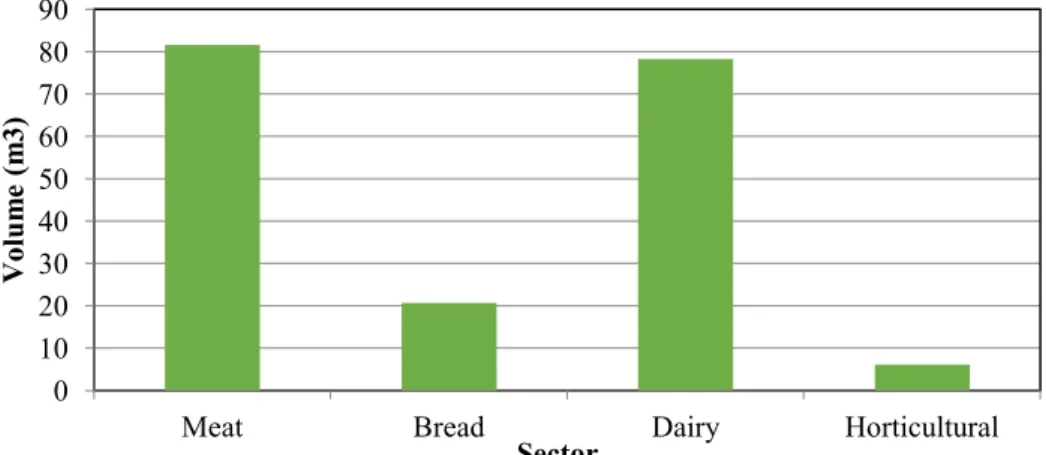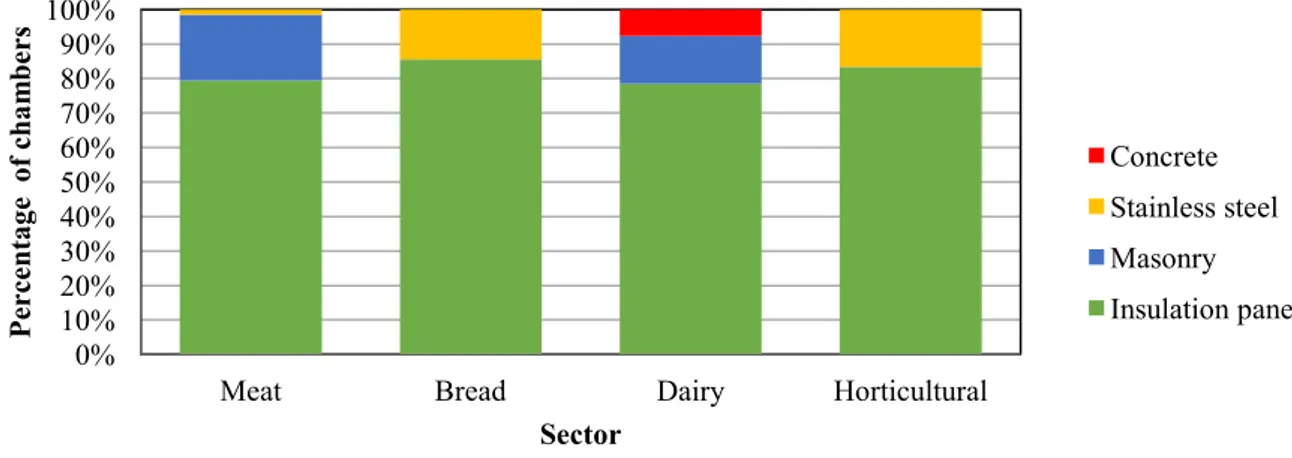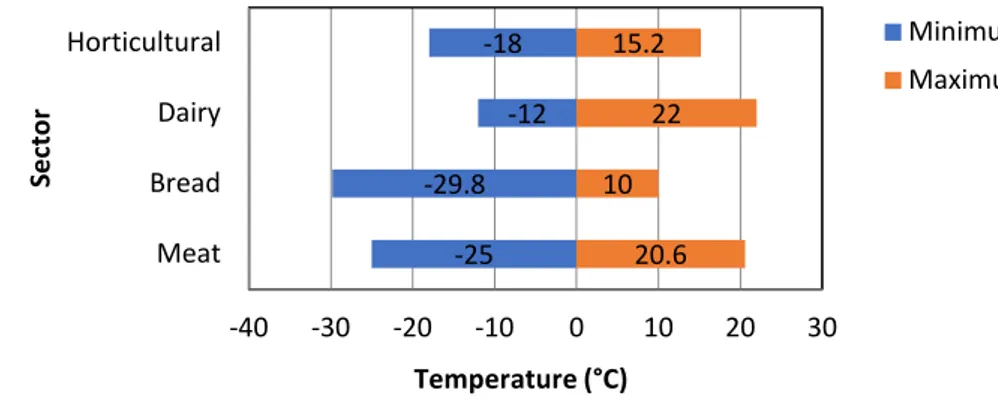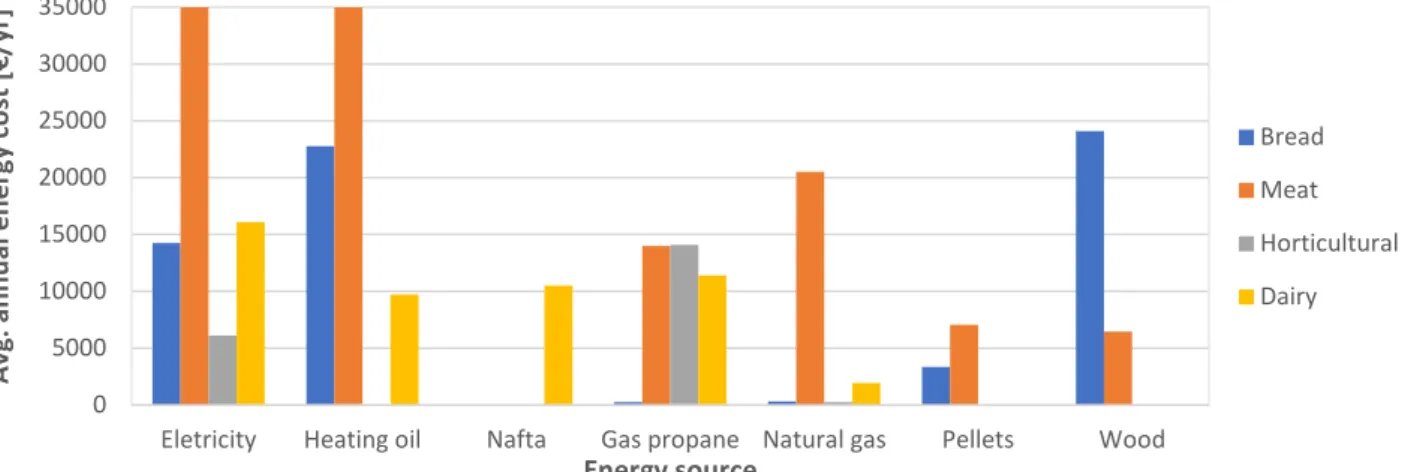Manuscript ID: 983 DOI: 10.18462/iir.icr.2019.0983
Characterization of refrigeration systems in the Portuguese
food processing industry
Diogo MORAIS
(a), Pedro D. GASPAR
(a,b), Pedro D. SILVA
(a,b), Luís C.
PIRES
(a), Luís P. ANDRADE
(c,d,e), José NUNES
(c)(a) University of Beira Interior, Rua Marquês d’Ávila e Bolama, 6201-001, Covilhã, Portugal,
dinho@ubi.pt
(b) C-MAST - Centre for Mechanical and Aerospace Science and Technologies, Covilhã, Portugal,
dinis@ubi.pt
(c) Agriculture School, Polytechnic Institute of Castelo Branco, Quinta da Senhora de Mercoles,
6001-909 Castelo Branco, Portugal, jnunes@ipcb.pt
(d) CATAA - Food Technology Support Center, Centro de Apoio Tecnológico Agro Alimentar,
Castelo Branco, Portugal, luispa@ipcb.pt
(e) CERNAS – Centro de Estudos em Recursos Naturais, Ambiente e Sociedade, Castelo Branco,
Portugal, luispa@ipcb.pt
ABSTRACT
This paper presents the results of audits performed in 60 companies of the food processing industry, specifically of meat, dairy, horticultural and bread products. The refrigeration volume, type of refrigeration system, refrigerant, building and insulation materials of infrastructure and refrigeration chambers, average air temperature and humidity, and the energy consumption are presented, compared and discussed per sector. The analysis allows to provide several measures and best practices aimed for the improvement of the thermal performance and energy efficiency of the food processing industry. The implementation of simple and very cost-effective transversal electricity savings measures such as awareness and/or training of operators, proper maintenance and monitoring tasks can benefit the sector. Tailored energy efficiency measures by sector, which may offer savings on several levels, are discussed. These best practices may increase productivity and competitiveness and reduce the environmental impact, and thus improve the global sustainability of the Portuguese food sector.
Keywords: Food Processing Industry, Characterization, Refrigeration System, Audit, Best Practices.
1. INTRODUCTION
The world's population is increasing, and with it also increases the need to produce more food. According to forecasts of the Food and Agriculture Organization of the United Nations (FAO), the global food production will increase by 70 percent to sustain the world population expected to reach 9 billion by the year 2050 (Morais et al., 2018). Currently, the food industry still faces many losses during the food chain, in part due to the unproper conservation conditions to which products are subjected. It is estimated that one-third of all food produced is lost during the steps preceding the final consumption (Gustavsson et al., 2011). For companies in the agro-food sector, these losses are sometimes crucial for their continuity in the market. In the case of Portugal, the manufacturing industry is made up mostly of small and medium-sized enterprises (SMEs), representing, in 2016, 11% of the country's economic activity. Given its economic characteristics, it is essential for SMEs to minimize the ratio between the produced and lost product.
Another factor that also has a high weight in the continuity of a company is the energy bill. The equipment used in the agro-industry requires more energy to operate due to its characteristics, and without the correct utilization, the energy consumption will be greater. For example, one of the main reasons for the high energy consumption in the conservation chambers is the considerable thermal load caused by infiltration of the surrounding air while the doors are open (Gil-Lopez et al.,
2013). In order to reduce this expense, it is necessary to adopt measures that aim at operational efficiency. Energy efficiency measures can go from simple and costless measures to measures that require an initial investment, but which translate into a surprising reduction of long-term energy expenditure. One way to assess the energy efficiency of an industry is through energy indicators, which aim to gain an understanding of the major techno-economic influences in industry’s final energy consumption, and in individual sub-industries or industries (Morais et al., 2018). Food quality control is necessary, both to protect the consumer against disease and to maximize the efficiency of the food industry (Ghaani et al., 2016). However, as in case of food storage in controlled environment chambers, the energy consumption could result very high especially when these devices are not optimally designed.This article characterizes the refrigeration systems of the food processing industry in Portugal, based on an audit conducted to 60 companies under the project +AGRO (www.maisagro.pt).
2. ENERGY EFFICIENCY
The term "efficiency" describes, according to Hordeski (2005), the capacity of equipment that operate in cycles or processes, to produce the expected results. In a physical view, the concept of "efficiency" would be limited to processes in which there is energy conversion and in which the initial and final forms are visible or perceptible - kinetic, potential and electric energy. In a simpler way, energy efficiency can be defined as the ratio between the amount of final energy used and a produced good or service performed. The technologies around energy efficiency are a way to reduce the energy consumption without change services or consumer’s behavior (Pradella et al., 2017). There are two sets of energy efficiency measures that can be applied, being classified as transversal measures and specific measures, oriented to each type of industry. The transverse measures translate four groups of technological performance: Electric Motors, Heat and Cold Production, Lighting, Industrial Process Efficiency and Other Measures not specified. (Evans & Gigiel, 2007, Evans & Gigiel, 2010, Evans et al., 2014). Surveys demonstrated that energy savings of about 30-40% were achievable by optimizing usage of stores, repairing current equipment and retrofitting of energy efficient equipment (Evans et al., 2014b).
For practical use of these indicators it is necessary to simplify the presentation by constructing the corresponding aggregates for most structural effects. Structural changes, the effects of international trade and permanent changes in energy consumption are mainly driven by improvements in efficiency. These improvements can be explained mainly by various technological changes, as well as influenced by other factors:
• Changes in technical efficiency;
• Replacement of technological processes;
• Changes in the manufacturing process used, (e.g., dry-path wet-making ceramics or vice-versa) that reduces the process energy consumption.
3. METHODOLOGY
The present study is a summary of the main results of an activity of project +AGRO: Organizational, Energy and Occupational Health and Safety Qualifications in the AgriFood Industry (Project 04 / SIAC / 2015 – SIAC 16159) (www.maisagro.pt) (Gaspar et al., 2018). The Project +AGRO aims to qualify SMEs in the agri-food sector, namely in the product subsectors of Meat, Horticultural, Dairy and Bread/Bakery products. The project focused in three topics of upmost important for the competitiveness of the agri-food processing industries: Occupational Safety and Health (OSH): Energy efficiency; and Organizational management of the productive processes. The project activities included the characterization of these topics in each subsector. The results of audits conducted to characterize the subsectors were used to develop a set of computational tools based on ICT as well as to develop specific good practices tools to reduce the inefficiencies. Companies were contacted to explain the objectives of the study and what was intended with their participation. After the first contact, it was necessary to visit all the facilities to present the project in a more dynamic and interactive way, allowing to know the dynamics of the company.
To carry out the initial information collection, a data collection model was developed that reflected the current characteristics of the company / industry.
Objectives: To carry out a general characterization and an energetic characterization of the companies under study.
Sample: The data collection model was applied to 60 agri-food companies from 4 different subsectors: Meat, Horticultural, Dairy and Bread/Bakery products.
Variables: The following variables were analyzed: Chamber volume, material used for thermal insulation and flooring, air temperature and humidity and energy consumption.
Method of Collection: Personally, through meetings marked with the companies surveyed, and using appropriate equipment.
In order to maintain the privacy of the companies, a numerical codification was adopted and assigned to each company according to the sector of operation and the region.
In the energy characterization component of each company, it was necessary the installation of energy analyzers in the electric boards, which allowed the acquisition of the necessary data for the elaboration of the study. For refrigeration and freezing equipment, the data collected concern the temperature and humidity inside the chambers. To obtain the data, the following equipment was used: Individual Protective Equipments; Clamp meter; Multimeter; Power analyzers; Multicontacts; Infrared Distance Meter; Camera; Thermographic camera; Other general tools. Data were also required from companies, such as:
• Energy consumption (electricity, heating oil, natural gas, propane gas, firewood, naphtha, pellets, others);
• Characteristics of tariffs and consumption of electricity; • Infrastructures (plant location);
• Features with heat generators;
• Disaggregation of the consumption of electric energy; • Characteristics of cold rooms;
• Specification of cooling systems.
4. RESULTS
Based on the audits results, it was possible to characterize the refrigeration systems used in the Portuguese food processing industry. The sectors with the highest volume in the conservation chambers, as shown in Fig. 1, are the meats and dairy sectors, with an approximate average of 80 m3, followed by the bakery sector (20 m3) and the horticultural sector (8 m3).
Figure 1: Average volume of chambers by sector
80% of the conservation chambers use thermal insulation panels, as shown in Fig. 2. A correct choice of materials used in the construction of the chambers is the first step to increase energy efficiency. Inherent in this choice are factors such as the method of manufacture and the necessary investment that sometimes prove to be obstacles to business.
0 10 20 30 40 50 60 70 80 90
Meat Bread Dairy Horticultural
V ol ume (m3 ) Sector
Figure 2: Material used in the construction of chambers of refrigeration and freezing
For the coating of the chambers, the choice fell to the concrete with 75% of use. From Fig. 3, it is still possible to verify that the horticultural sector is the one that presents a greater use of thermal insulation panels for the coating of the chambers.
Figure 3: Material chosen for the coating of chambers
The thermal insulation materials employed, with approximately 85% use of the polyurethane, is shown in Fig. 4. In the sectors of the bakery and horticultural is the insulation of choice. On the other hand, about 20% of the companies surveyed in the dairy sector do not have any thermal insulation inside the chambers. In this situation it will be expected a higher thermal load and, consequently, a greater difficulty of the refrigeration equipment to maintain the temperature inside the chamber.
Figure 4: Thermal insulation materials used in chambers 0% 10% 20% 30% 40% 50% 60% 70% 80% 90% 100%
Meat Bread Dairy Horticultural
Percen ta ge o f ch am bers Sector Concrete Stainless steel Masonry Insulation panel 0% 10% 20% 30% 40% 50% 60% 70% 80% 90% 100%
Meat Bread Dairy Horticultural
Percen ta ge of m at eri al Sector Stainless steel Mosaic Insulation panel Concrete 0% 10% 20% 30% 40% 50% 60% 70% 80% 90% 100%
Meat Bread Dairy Horticultural
P ercen ta ge of m at eri al Sector Cork Uncoated Polyurethane
The type of refrigerant used in refrigeration systems was also evaluated. It can be seen from Fig. 5 that industries still resort to fluids that have been banned, such as R22 (6%). There is also a great use of R404A (75%), which according to the Food & Drink Federation, will be banned from the Market in early 2020 because of its GWP (Global Warming Potential) value. Thus, this is a very important insight in the characterization, because the Portuguese agri-food industry must start to retrofit their cooling systems to adopt alternative refrigerants.
Figure 5: Breakdown of the type of Refrigerant (%)
Regarding the environment inside the chambers, as shown in Fig. 6, there is a high variation between the minimum and maximum values of air temperature, especially in the meat and bakery sectors. This air temperature range force the refrigeration equipment to work almost continuously resulting in higher values of energy consumption. Fig. 7 shows the average measured values of air relative humidity.
Figure 6: Range of temperature values inside the chambers, per sector
Figure 7: Range of relative humidity values inside the chambers, per sector
2% 75% 7% 2% 2% 6% 2% 2% 2% R427A R404A R407A R437A R422D R22 R417A R12 R134A -25 -29.8 -12 -18 20.6 10 22 15.2 -40 -30 -20 -10 0 10 20 30 Meat Bread Dairy Horticultural Temperature (°C) Sec to r Minimum Maximum 58.8 60 60 65 99 93.5 93.5 73 0 20 40 60 80 100 120 Meat Bread Dairy Horticultural Relative humidity (%) Sec to r Maximum Minimum
Depending on the needs of each sector, different refrigeration systems are adopted. Approximately 50% of the systems used in the different sectors are of the “individual” type, being the choice of all companies in the horticultural sector, as shown in Fig. 8. This individuals’ systems are constituted by a compressor, a condenser, an expansion valve and an evaporator.
Figure 8: Types of Refrigeration systems, per sector [%].
Due to the chambers characteristics, it’s necessary to have artificial light to provide the necessary work conditions to operators, so, illumination is another important factor when it comes to efficiency in industries (Sudhir, 2016). The most used lighting systems is the fluorescent type, as you can see in Figure 9, whose efficiency is very poor when compared with LED
Figure 9: Illumination used inside the refrigeration chambers, per sector (%)
The examination of Fig. 10, where the energy expenses by energy source is presented, shows that the preference for renewable sources is not yet part of the choices of the sectors under analysis, perhaps justified by the higher investment required by new equipment acquisition. However, between January and July 2018, 58% of the electricity produced in Portugal came from renewable sources (APREN, 2018).
Figure 10: Average annual energy cost per energy source (€/year)
0% 10% 20% 30% 40% 50% 60% 70% 80% 90% 100%
Bread Meat Horticultural Dairy
Compact
Central Cooling / Compact Individual / Compact Individuals Cold Central 0% 10% 20% 30% 40% 50% 60% 70% 80% 90% 100%
Bread Meat Horticultural Dairy
Led Incandescent Fluorescent 0 5000 10000 15000 20000 25000 30000 35000
Eletricity Heating oil Nafta Gas propane Natural gas Pellets Wood
Av g. a nn ua l e ne rg y c os t [ €/ yr ] Energy source Bread Meat Horticultural Dairy
Figure 11: Storage conditions of cold rooms, by sector
Based on the results obtained, the storage conditions in the Portuguese food processing industries can be classified as good, in Fig. 11. The bakery sector has a lower classification compared to the meat, horticulture or dairy sectors.
5. CONCLUSIONS
The present study aims to characterize the refrigeration systems used in the different food sectors in Portugal, based on efficiency. Similar studies were carried out by Bastos et al. (2013), Gaspar et al. (2013), Nunes et al., (2014, 2015) and Morais et al., (2018), . It turns out that obtaining electricity for the operation of the equipment still comes from most fossil sources, which contributes to the increase of carbon dioxide emissions to the atmosphere. With the increase in the demand for food, it is necessary to maximize the conservation processes, namely the refrigeration chambers and the first step is through the analysis of the energy consumptions and the conditions of construction. Approximately 80% of the industries use insulation panels and a good thermal insulation for the construction of the chambers, showing concern for the chambers construction and structure as well as its insulation properties. Regarding the material used for coating, many companies opt for the concrete.
The measured temperatures present a large amplitude, indicating thermal losses. These losses can be caused not only by the incorrect sizing of the chamber and the refrigeration system for the product to be conserved, but also by the logistics processes, such as the opening of doors. The use of LED lighting is also not yet a 100% adopted by industries, as shown in Figure 9, which contributes to the decrease in the efficiency of the chambers. Concerning the refrigeration systems, some of the refrigerating fluids used have already been banned from circulation and others will be banned in the next 2 years. Changing fluids sometimes involves retrofitting or replacing the equipment, which is associated with a cost that is not always tolerable for SMEs, but which is mandatory for those seeking to maximize manufacturing processes. Secondly, some freezing/refrigeration equipment is not always sized for the effect in question, having implications in the thermal load to which they will be subject and therefore, the amount of energy that they use. From Figure 10 it can be concluded that the meat industry is the one that spends most on energy, with approximately 100 000 €/year (average per plant), and is due in part to the nominal power that the equipment has to ensure freezing temperatures.
The state in which the chambers of refrigeration of the different sectors are in general, can be evaluated like good.
ACKNOWLEDGEMENTS
This study is within the activities of Project “PrunusPÓS - Optimization of processes for the storage, cold conservation, active and/or intelligent packaging and food quality traceability in post-harvested fruit products”, project n.º PDR2020-101-031695, Partnership n.º 87, initiative n.º 175, promoted by PDR 2020 and co-funded by FEADER within Portugal 2020.
0% 10% 20% 30% 40% 50% 60% 70% 80% 90% 100%
Bread Meat Horticultural Dairy
Good Moderate
REFERENCES
APREN. 2018. Boletim Energias Renováveis – Boletim Mensal 07/2018 - Ass. de Energ Reno. Ayres, R. U., Turton, H., & Casten, T. 2007. Energy efficiency, sustainability and economic growth.
Energy, 32(5), 634–648.
Bastos, E., Cruz, A., Silva, P.D., Gaspar, P.D. 2013. Caracterização dos consumos de energia eléctrica dos sistemas de refrigeração de empresas no setor agroindustrial - Beira Interior Norte. Int. Conference on Engineering ICEUBI 2013, Covilhã, Portugal.
Brito, P., Lopes, P., Reis, P., & Alves, O. 2014. Simulation and optimization of energy consumption in cold storage chambers from the horticultural industry. Int. J. Energy Environ Eng 5(88). Gaspar, P. D., & da Silva, P. D. 2015. Handbook of Research on Advances and Applications in
Refrigeration Systems and Technologies. IGI Global, Hershey.
Ghaani, M., Cozzolino, C. A., Castelli, G., & Farris, S. 2016. An overview of the intelligent packaging technologies in the food sector. Trends in Food Science and Technology 51, 1-11. Gil-Lopez, T., Castejon-Navas, J., Galvez-Huerta, M. A., & O’Donohoe, P. G. 2014. Energetic,
environmental and economic analysis of climatic separation by means of air curtains in cold storage rooms. Energy and Buildings 74, 8-16.
Morais, D., Gaspar, P. D., Silva, P. D., Andrade, L. P., Nunes, J. 2018. Energy consumption and energy efficiency measures in the Portuguese food processing industry. International Congress on Organizational Management, Energy Efficiency and Occupational Health and Safety in Agrifood Industry (+AGRO 2018), Castelo Branco, Portugal.
Morais, D., Gaspar, P. D., Silva, P. D., Andrade, L. P., Nunes, J. 2018. Assessment of the energy consumption and technologies in the bakery and pastry sector – The Portuguese case study. 2nd International Conference on Sustainable Energy and Resource Use in Food Chains, ICSEF 2018, Paphos, Cyprus.
Nunes, J., Silva, D., Andrade, P., & Gaspar, D. 2015. Avaliação energética das centrais de fruta da Região da Beira Interior. Int. Conference on Engineering – Engineering for Economic Development ICEUBI 2015, Covilhã, Portugal.
Nunes, J., Silva, P. D., Domingues, L., Andrade, L. P., & Gaspar, P. D. 2014. Energy evaluation of refrigeration systems in Portuguese fruit and vegetable industry. 3rd Int. Conference on Sustainability and the Cold Chain, Twickenham, London, 397-404.
Nunes, J., Silva, P. D., Andrade, L. P., & Gaspar, P. D. 2014. Characterization of the specific energy consumption of electricity in the Portuguese sausage industry. WIT Transactions on Ecology and the Environment, 186, 763-774.
Nunes, J., da Silva, P. D., Andrade, L. P., Domingues, L., & Gaspar, P. D. 2016. Energy assessment of the Portuguese meat industry. Energy Efficiency, 9(5), 1163-1178.
J. Nunes, Pedro D. Silva, L.P. Andrade, Pedro D. Gaspar. Key points on the energy sustainable development of the food industry – Case study of the Portuguese sausages industry. Renewable and Sustainable Energy Reviews (57), 393-411.
Pradella, A. M., Costa, S. E. G., Lima, E. P. De, & Silva, W. V. 2017. Energy efficiency indicators in the food industry: a systematic review. 24th Int. Conference on Production Research ICPR 2017, 685-690.
Silva, P.D., Gaspar, P.D., Andrade, L.P., Nunes, J., & Domingues, C. 2016. Best practices in refrigeration applications to promote energy efficiency – The Portuguese case study, Ch. 3, in D. Cunningham (Ed.), Food Industry: Assessment, Trends and Current Issues, Series Food and Beverage Consumption and Health, Nova Publishers, USA.
Sudhir, L. S., 2016. Led Illumination: A Case Study on Energy Conservation. Int. J. Engineering Research and General Science. 4(2), 283-289.




